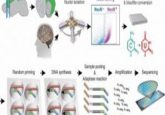Two colors are better than one for DNA methylation assays

A modification of the standard fluorescent cytosine extension assay for DNA methylation improves its precision and suitability for high-throughput screens.

The cytosine extension assay (CEA) assesses global DNA methylation levels by tracking the methylation of a CpG-containing restriction enzyme site, for example CCGG. When methylated, these sites cannot be digested by HpaII but can be digested by its isoschizomer, MspI. The relative digestion of CCGG sites in a DNA sample by HpaII compared to MspI reflects the extent of DNA methylation. Using CEA, researchers can assess the incorporation of a fluorescently labeled cytosine through end-filling by DNA polymerase of the 5´ guanosine overhang at the HpaII/MspI cut site.
In the April issue of BioTechniques, Craig Parfett and his colleagues at Health Canada present an improved version of CEA. In standard CEA, the same fluorescently colored cytosine is used in the extension reactions following HpaII and MspIdigestion. In their new version, Parfett’s team used a different fluorescently colored cytosine for the extension reaction of each digest, after which the reactions were combined for downstream purification and signal detection. This two-color CEA showed greater precision compared to the one-color CEA and is well-suited to high-throughput screening.





